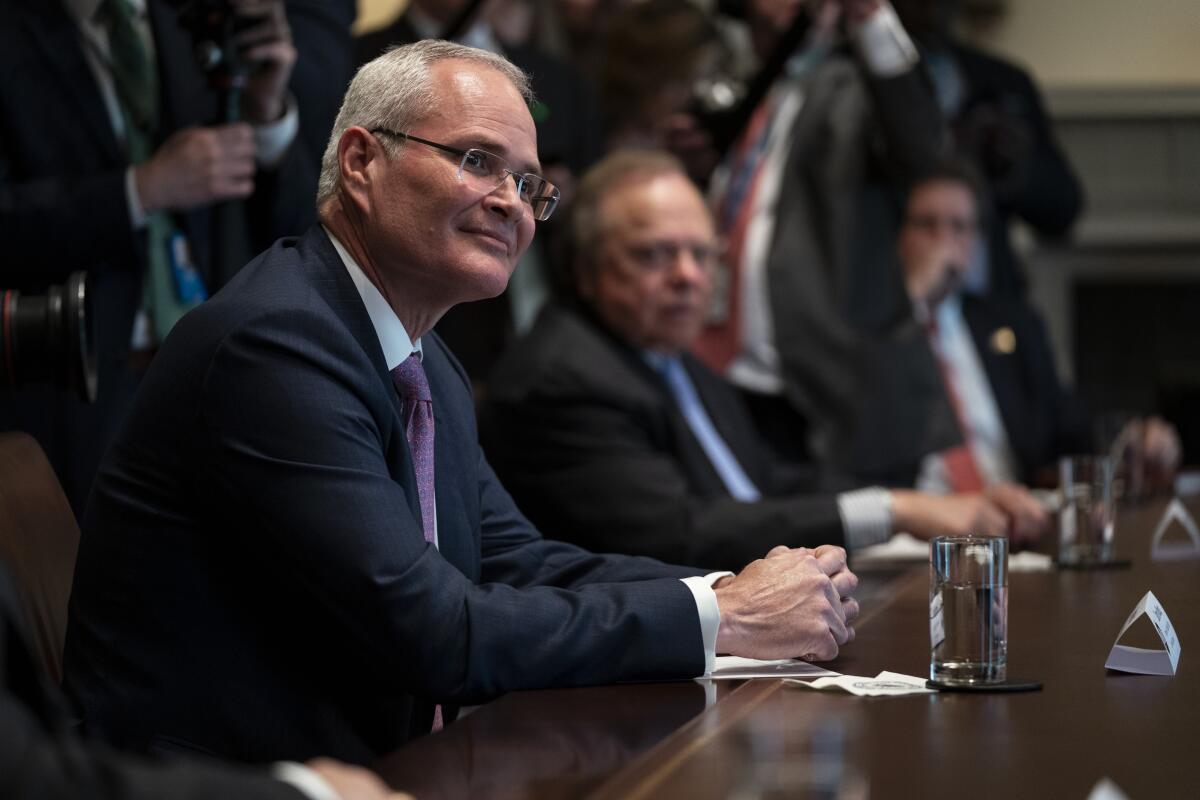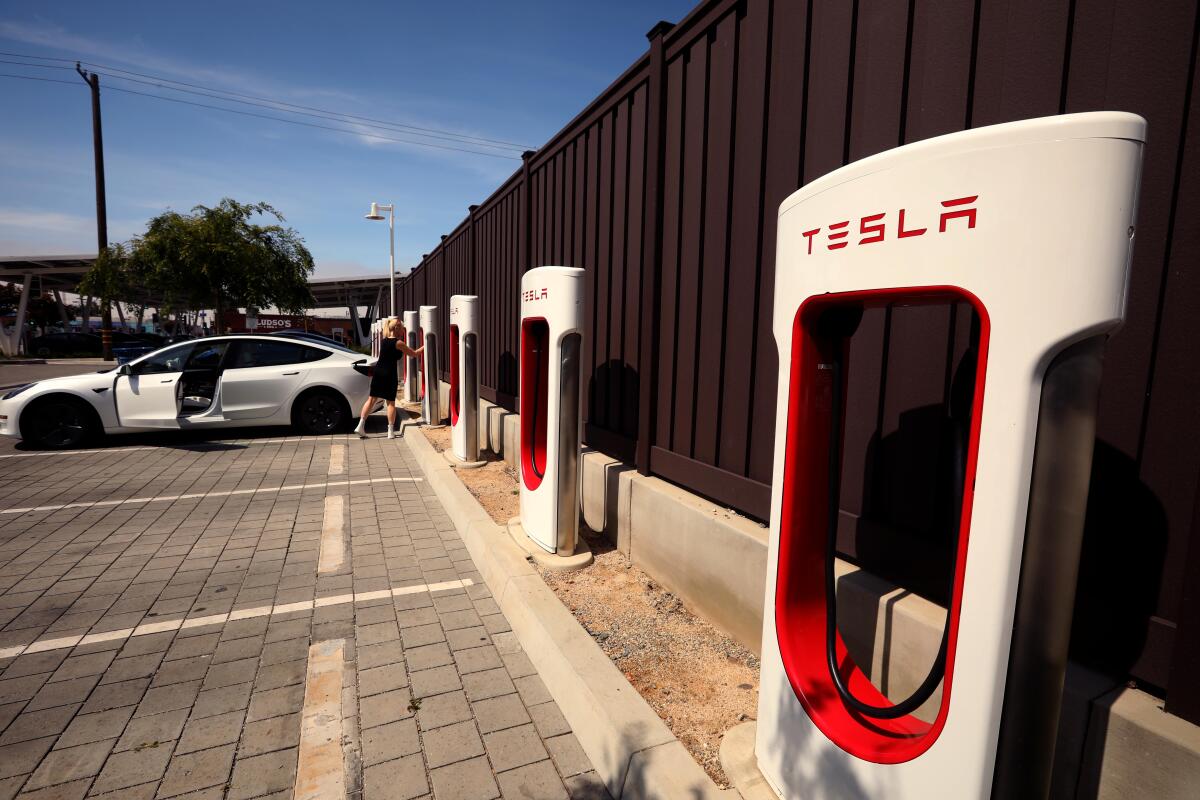Column: Here’s what Exxon’s CEO gets wrong about the climate crisis

- Share via
Oil and gas conglomerate Exxon Mobil could be a key player in global efforts to combat the climate crisis — if only governments would remove burdensome regulations and stop wasting money on inefficient clean energy incentives.
Sound contradictory? It is.
Nevertheless, that was the message shared by Exxon Chief Executive Darren Woods on Monday in Beverly Hills.
You're reading Boiling Point
Sammy Roth gets you up to speed on climate change, energy and the environment. Sign up to get it in your inbox twice a week.
You may occasionally receive promotional content from the Los Angeles Times.
As I watched a livestream of the Milken Institute Global Conference, I was frustrated but not surprised to hear Woods imply that emerging technologies such as carbon capture and green hydrogen — on which Exxon and other oil giants are spending a tiny fraction of their cash — will be the main drivers of climate progress. We need those technologies for sure. But solar panels, wind turbines and batteries are cheap enough and reliable enough to get us most of the way to 100% clean energy, scientists say.
Woods, however, said hardly anything about solar and wind power, instead calling on the federal government to ease permitting regulations to make it easier for companies to build large-scale carbon capture and green hydrogen infrastructure.
“Permitting becomes significant bottleneck to advancing those projects,” Woods said.
He’s not entirely wrong. But he’s not telling the whole story.
I also shook my head in amazement as Woods suggested that a major barrier to slashing carbon pollution is that the world lacks “a system for accounting for carbon.” Until we can better calculate the costs and benefits of reducing emissions across different sectors of the economy, he said, we’ll continue to spend too much money on some climate programs and not enough money on others — wasting taxpayer dollars in some places while missing low-hanging fruit in others.
As an example, he implied that President Biden’s Inflation Reduction Act allocates too much money for electric vehicle subsidies — despite the fact that cars, trucks and other forms of transportation are America’s largest source of climate pollution.
“You want to make sure you have the tools available to prioritize the most effective steps first,” Woods said.
“That’s the point of a carbon accounting system,” he added.

Let’s set aside the fact that Exxon is a member of several trade groups that opposed Senate Bill 253 — the landmark bill approved by California lawmakers last year requiring major companies such as Exxon to publicly disclose their carbon emissions.
The deeper problem with Woods’ argument is that “prioritizing the most effective steps first” is a recipe for disaster.
Earth just experienced its 11th-straight record hot month. Heat waves, wildfires, droughts, floods — all of them are deadlier and more destructive then they were a few years ago. We shouldn’t ignore energy costs and smart use of taxpayer dollars, but in the absence of a livable climate, nothing else matters. With scientists telling us we need to cut carbon pollution more than 40% in the next six years, we don’t have time to waste prioritizing the most effective steps. We need to move on all fronts, ASAP.
And how did we get to this critical point in human history?
In large part because Exxon and other fossil fuel profiteers waged phenomenally successful, decades-long political campaigns of climate change denial and delay. It’s a horrific story that my L.A. Times colleague Susanne Rust helped expose in 2015.
In some ways, it’s a story that continues today.
Just last week, House Democrats released internal documents produced by a long-running investigation into the oil industry. In one document, an Exxon official expresses the view that the goals of the 2015 Paris climate accord are not realistic — despite the company publicly endorsing the accord, as Emily Atkin and Arielle Samuelson report in their Heated newsletter.
Another document shows the same Exxon official recommending to a fossil fuel industry group that it delete all references to the Paris accord, writing that those references “could create a potential commitment to advocate on the Paris Agreement goals.”
So yeah, I’m skeptical when Woods starts off by saying, “Our view is there’s a need to do more math in this space.”
Fortunately, Woods shared the stage with Biden’s clean energy advisor, John Podesta.

Dealing with climate change, Podesta said, is “not an accounting problem.”
“We’re seeing people drowning in Brazil from flash flooding. Extreme weather across the United States. This is going to get worse and worse as the temperature heats up,” Podesta said. “So the question is, what’s the speed and scale with which we’re moving to try to move from fossil fuels, which have powered our economy for decades, and we’re not getting rid of tomorrow?”
“Companies like Darren’s can be part of the solution,” he added. “My beef with him is I just think he’s not going fast enough.”
Podesta also highlighted the rapid pace of solar energy growth, and called out Exxon for not investing more in renewables.
“I want them to spend more,” he said.
By the end of the Milken Institute discussion, it was clear why Exxon hasn’t spent more on climate-friendly power.
Oil and gas continue to be the company’s most reliable profit centers — a fact made clear by Exxon’s $60-billion acquisition of Texas-based oil and gas producer Pioneer Natural Resources, which was cleared by federal officials last week. The purchase will greatly expand Exxon’s ability to drill for fossil fuels in the Permian Basin region of eastern New Mexico and western Texas.
Woods made the case that the purchase will be good not only for “the economy” (which ignores the fact that the climate crisis is terrible for the economy) and for “consumers” (which ignores the fact that the climate crisis is terrible for human beings).
He also claimed Exxon’s fracking operations “will be good for the environment as well.” That head-scratching statement is based on the company’s plans to power its facilities with clean energy and limit heat-trapping methane releases — useful but still totally inadequate steps that ignore all the pollution unleashed when the oil being extracted is later burned in cars and trucks.
The best I can say for Woods is that he wasn’t shy about acknowledging who pays his salary.
“As a business, we’ve got to understand ... what are the returns for our shareholders,” he said.
Love modern capitalism or hate it, it’s what we’ve got. Averting climate catastrophe will necessitate leveraging the system we’ve got — pushing politicians to regulate the hell out of companies such as Exxon, but also holding our noses and collaborating with at least some of those companies, as technology and economics and politics require, to claw our way across the finish line.
On that note, here’s what’s happening around the West:
TOP STORIES

Heeding the calls of Indigenous leaders and conservationists, President Biden expanded two national monuments in the Golden State. Using his powers under the Antiquities Act, Biden expanded Southern California’s San Gabriel Mountains National Monument by more than 100,000 acres and protected a Northern California region rich in biodiversity and sacred to the Patwin people by adding it to Berryessa Snow Mountain National Monument, as my L.A. Times colleague Alex Wigglesworth reports. Let’s not forget, though, that establishing protections is just the first step. High Country News’ Anna V. Smith explored what it’s been like for federal agencies and Native American tribes working to manage and protect Utah’s Bears Ears National Monument.
How is long-buried DDT making its way from the ocean floor off the coast of Los Angeles into the food web, endangering all of us who enjoy eating fish? A new study — one of many sparked by my L.A. Times colleague Rosanna Xia’s groundbreaking DDT reporting — finally sheds some light on the matter. It seems the toxic chemical is coming into contact with zooplankton that get eaten by deep-sea fish, then making its way up the food chain from there, Rosanna writes. In other Pacific Ocean news, The Times’ Hayley Smith and Sean Greene reported on majestic blue whales in Southern California’s Santa Barbara Channel, and the deafeningly loud cargo ships going in and out of the L.A. and Long Beach ports that can make life hell for the mammals.
Why is it so difficult to deliver water from the Sacramento-San Joaquin River Delta to California farms and cities without killing endangered fish? The Times’ Ian James toured the pumping plant at the heart of the problem, writing that the risk for fish “is not just that they may be drawn into pump machinery and killed, but also that they will first be pulled into waters where they are easy prey.” Ian also wrote about the Klamath River dam removals along the California-Oregon border, reporting that Iron Gate Dam — the tallest of the four, at 173 feet — is finally coming down. “There’s just been so much that’s been put into this day coming, so many people contributing to it,” a ceremonial leader of the Karuk tribe said.
THE ENERGY TRANSITION

Tesla is opening some of its Supercharger stations to some non-Tesla electric vehicle drivers — but not all stations and not all EV drivers, at least not yet. That much became clear after Gov. Gavin Newsom’s office posted a video that was interpreted by many viewers as implying Tesla was moving more quickly to open up its chargers — which was not quite right, as The Times’ Russ Mitchell made clear. If you’re looking for another alternative to gasoline, The Times’ Rachel Uranga has a first look at what a high-speed train from Southern California to Las Vegas might look like. And if you’re just frustrated by high gas prices, California’s oil refinery watchdog is getting close to calling out the industry for price gouging, per the San Diego Union-Tribune’s Rob Nikolewski.
The Biden administration released congressionally mandated rules to speed up the federal approval process for energy projects — and it sounds like they found a way to make the new rules as beneficial for renewable energy and as onerous for fossil fuels as possible. Details here from the New York Times’ Coral Davenport. The administration is also moving forward with plans for floating wind energy off the coast of Oregon, per Oregon Public Broadcasting’s Monica Samayoa. Offshore wind took a step forward in Southern California last week too, as noted in Politico’s California Climate newsletter (scroll down).
It was the best of times for Berkshire Hathaway Energy. Then, suddenly, it was the worst of times — and Warren Buffett admits he didn’t see it coming. Just two years ago, the so-called Oracle of Omaha called Berkshire’s energy business one of his company’s four “giants.” But now, Reuters’ Jonathan Stempel writes, “he fears its business model may be broken,” torpedoed by wildfire liabilities that could reach tens of billions of dollars as global warming fuels ever-more-destructive blazes, some of which have been sparked by Berkshire-owned utility lines. Despite the climate threat to Berkshire’s business model, Buffett and most of his fellow shareholders continue to oppose carbon disclosure resolutions. In other utility company news, Pacific Gas & Electric is seeking approval to get into business with investment firm KKR, the New York Times’ Ivan Penn reports. KKR owns a big chunk of San Diego-based Sempra Energy’s infrastructure assets, including a liquefied natural gas export plant being built in Texas.
POLITICAL CLIMATE

A judge is leaning toward dismissing a climate lawsuit brought by 18 California children against the federal government, seeking faster action to phase out fossil fuels. The U.S. Department of Justice asked a federal judge to dismiss the case — and although he hasn’t ruled yet, the judge said he was inclined to side with the government, describing climate as a challenge to be dealt with by Congress and the president, my L.A. Times colleague Tony Briscoe reports. In Oregon, meanwhile, a federal appeals court rejected a similar youth climate lawsuit at the Biden administration’s urging, per the Associated Press’ Gene Johnson.
The likely Republican U.S. Senate candidate in Nevada has made comments supporting nuclear waste storage at Yucca Mountain, calling the project an economic winner — a surprising position in a swing state where statewide candidates typically oppose Yucca Mountain. Will those comments come back to haunt Sam Brown in November, and possibly help keep the Senate in Democratic hands? Here’s the story from The Times’ Seema Mehta. Long term, if we want to keep getting roughly one-fifth of our nation’s power from nuclear reactors (which would be super helpful for climate, as I’ve written previously), we’ll need somewhere to store all the spent nuclear fuel, which can remain radioactive for tens of thousands of years.
Gov. Gavin Newsom signed a bill last year protecting Joshua trees from housing, solar farms and other development. Now a desert lawmaker wants to reverse some of those protections — and his legislation is moving forward in Sacramento, clearing its first committee last month, as Ryan Sabalow reports for CalMatters. Such is the constant push and pull between conservation and development, even in California. Elsewhere in the ever-changing desert, The Times’ Alex Wigglesworth penned a fascinating story on Danielle Wall, a “tattooed, cutoff-clad 29-year-old” who “has become the Joshua Tree area’s premier rattlesnake wrangler.”
AROUND THE WEST

Would California Forever be a modern-day sustainable city or an environmental train wreck? It looks like voters in Northern California’s Solano County will get a chance to decide, now that the project’s billionaire backers have seemingly gathered enough signatures to put a zoning code measure on the November ballot. Details here from The Times’ Connor Sheets. In other California Forever news, Connor and Karen Garcia write that the city of Vacaville’s vice mayor “is in the hot seat after it was revealed that he had earlier sought to associate his home loan business with the developer’s campaign” for the sprawling housing project.
There’s plenty of snow in the mountains feeding the Colorado River this year. But with parched soils and high temperatures fueled by climate change, scientists tell KUNC’s Alex Hager that we should prepare for less water in the river than we would have gotten in the past. In better news, the Colorado Sun’s Shannon Mullane reports that tribes in Colorado, New Mexico, Utah and Wyoming now have a permanent seat at the table in Colorado River conversations. And in Arizona, the Colorado River Indian Tribes — which hold the state’s largest and most senior Colorado River water rights — now have a lot more control over how they use their water, under a new agreement with the Biden administration. Details here from Inside Climate News’ Noel Lyn Smith.
Remember the 2023 “snow deluge” that rescued California from drought? Don’t expect another one, a new study concludes. “I would not be surprised if 2023 was the coldest, snowiest winter for the rest of my own lifetime in California,” one scientist told the Associated Press’ Brittany Peterson and Seth Borenstein. If you find that kind of news hard to process, maybe check out this beautiful story by the Arizona Republic’s Joan Meiners on local groups grappling with climate anxiety. “Communities everywhere are finding new ways to both celebrate and grieve life on Earth as a necessary step in saving what’s left,” she writes.
ONE MORE THING

If you love board games, I’ve got a hot tip for you.
In a new version of Settlers of Catan — known as Catan: New Energies — you have to choose between fossil fuels and renewable power as you build out human civilization. If you cause too much pollution, catastrophes ensue, NPR’s Nathan Rott reports.
Board games, movies, TV shows, theme park attractions — the more climate-enriched entertainment, the better.
This column is the latest edition of Boiling Point, an email newsletter about climate change and the environment in California and the American West. You can sign up for Boiling Point here. And for more climate and environment news, follow @Sammy_Roth on X.
Toward a more sustainable California
Get Boiling Point, our newsletter exploring climate change, energy and the environment, and become part of the conversation — and the solution.
You may occasionally receive promotional content from the Los Angeles Times.






